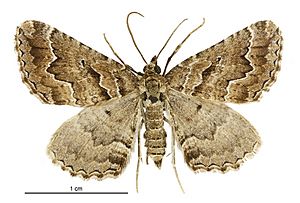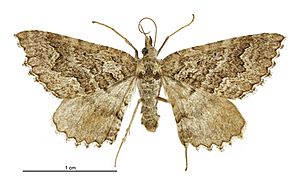Austrocidaria lithurga facts for kids
Quick facts for kids Austrocidaria lithurga |
|
|---|---|
 |
|
| Male | |
 |
|
| Female | |
| Scientific classification | |
| Kingdom: | |
| Phylum: | |
| Class: | |
| Order: | |
| Family: | |
| Tribe: |
Xanthorhoini
|
| Genus: |
Austrocidaria
|
| Species: |
A. lithurga
|
| Binomial name | |
| Austrocidaria lithurga (Meyrick, 1911)
|
|
| Synonyms | |
|
|
Austrocidaria lithurga is a type of moth that belongs to the Geometridae family. It is only found in New Zealand, meaning it is endemic there. The Department of Conservation considers this moth to be "at risk" because it is naturally uncommon.
Contents
Discovering the Austrocidaria lithurga Moth
Who Discovered This Moth?
This moth was first described by a scientist named Edward Meyrick in 1911. He originally gave it the name Hydriomena lithurga.
Meyrick studied a specimen that came from R. M. Sunley. Sunley found a pupa (the stage between a larva and an adult moth) on a Muehlenbeckia plant. This was at Mākara Beach in Wellington. Sunley then raised the pupa until it became an adult moth.
Later, in 1971, another scientist named John S. Dugdale moved this moth to the genus Austrocidaria. This is why its full name is now Austrocidaria lithurga.
Where is the Original Specimen Kept?
The very first specimen used to describe this species, called the holotype, is kept safe at the Natural History Museum, London.
Where Does the Austrocidaria lithurga Moth Live?
This moth is only found in New Zealand. It has been seen in the Wellington area, including places like Sinclair Head and Baring Head. It has also been found in south Marlborough and in Mid Canterbury. Scientists think it might also live in the Hawkes Bay area.
Life Cycle of the Austrocidaria lithurga Moth
When Do Adult Moths Appear?
The adult Austrocidaria lithurga moths are usually seen flying around in October and November.
How Does the Pupa Stage Work?
Before becoming an adult moth, the pupa of this species is found inside a loose cocoon. This cocoon helps protect the pupa as it changes.
What Does the Austrocidaria lithurga Moth Eat and Where Does It Live?
What Plants Do the Larvae Eat?
Scientists believe that the caterpillars (larvae) of this moth might eat plants from the Muehlenbeckia family. It has also been suggested that they might feed on small-leaved Coprosma species, which are known for their tangled, branching growth. However, the exact plants this moth prefers to eat are still a bit of a mystery.
What Kind of Places Does It Like to Live In?
The specific type of place this moth likes to live in is not fully known. But, it is thought that Austrocidaria lithurga prefers open areas with shrubs.
Why is the Austrocidaria lithurga Moth "At Risk"?
The New Zealand Threat Classification System has classified this moth as "at risk, naturally uncommon." This means that the moth is not very common in nature, and its population needs to be watched to make sure it stays safe and doesn't become endangered.

